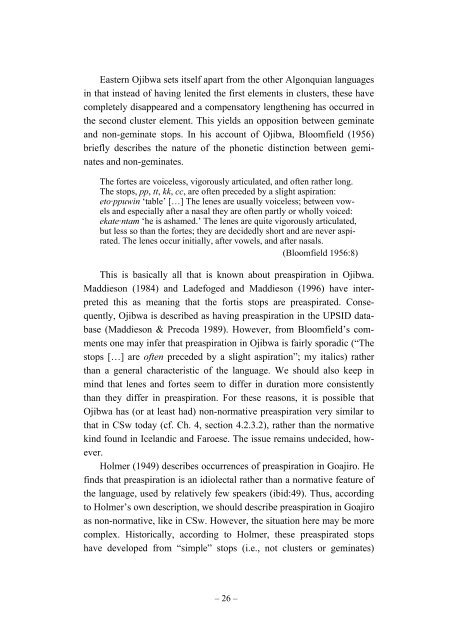Preaspiration in the Nordic Languages: Synchronic and Diachronic ...
Preaspiration in the Nordic Languages: Synchronic and Diachronic ...
Preaspiration in the Nordic Languages: Synchronic and Diachronic ...
You also want an ePaper? Increase the reach of your titles
YUMPU automatically turns print PDFs into web optimized ePapers that Google loves.
Eastern Ojibwa sets itself apart from <strong>the</strong> o<strong>the</strong>r Algonquian languages<br />
<strong>in</strong> that <strong>in</strong>stead of hav<strong>in</strong>g lenited <strong>the</strong> first elements <strong>in</strong> clusters, <strong>the</strong>se have<br />
completely disappeared <strong>and</strong> a compensatory leng<strong>the</strong>n<strong>in</strong>g has occurred <strong>in</strong><br />
<strong>the</strong> second cluster element. This yields an opposition between gem<strong>in</strong>ate<br />
<strong>and</strong> non-gem<strong>in</strong>ate stops. In his account of Ojibwa, Bloomfield (1956)<br />
briefly describes <strong>the</strong> nature of <strong>the</strong> phonetic dist<strong>in</strong>ction between gem<strong>in</strong>ates<br />
<strong>and</strong> non-gem<strong>in</strong>ates.<br />
The fortes are voiceless, vigorously articulated, <strong>and</strong> often ra<strong>the</strong>r long.<br />
The stops, pp, tt, kk, cc, are often preceded by a slight aspiration:<br />
eto·ppuw<strong>in</strong> ‘table’ […] The lenes are usually voiceless; between vowels<br />
<strong>and</strong> especially after a nasal <strong>the</strong>y are often partly or wholly voiced:<br />
ekate·ntam ‘he is ashamed.’ The lenes are quite vigorously articulated,<br />
but less so than <strong>the</strong> fortes; <strong>the</strong>y are decidedly short <strong>and</strong> are never aspirated.<br />
The lenes occur <strong>in</strong>itially, after vowels, <strong>and</strong> after nasals.<br />
(Bloomfield 1956:8)<br />
This is basically all that is known about preaspiration <strong>in</strong> Ojibwa.<br />
Maddieson (1984) <strong>and</strong> Ladefoged <strong>and</strong> Maddieson (1996) have <strong>in</strong>terpreted<br />
this as mean<strong>in</strong>g that <strong>the</strong> fortis stops are preaspirated. Consequently,<br />
Ojibwa is described as hav<strong>in</strong>g preaspiration <strong>in</strong> <strong>the</strong> UPSID database<br />
(Maddieson & Precoda 1989). However, from Bloomfield’s comments<br />
one may <strong>in</strong>fer that preaspiration <strong>in</strong> Ojibwa is fairly sporadic (“The<br />
stops […] are often preceded by a slight aspiration”; my italics) ra<strong>the</strong>r<br />
than a general characteristic of <strong>the</strong> language. We should also keep <strong>in</strong><br />
m<strong>in</strong>d that lenes <strong>and</strong> fortes seem to differ <strong>in</strong> duration more consistently<br />
than <strong>the</strong>y differ <strong>in</strong> preaspiration. For <strong>the</strong>se reasons, it is possible that<br />
Ojibwa has (or at least had) non-normative preaspiration very similar to<br />
that <strong>in</strong> CSw today (cf. Ch. 4, section 4.2.3.2), ra<strong>the</strong>r than <strong>the</strong> normative<br />
k<strong>in</strong>d found <strong>in</strong> Icel<strong>and</strong>ic <strong>and</strong> Faroese. The issue rema<strong>in</strong>s undecided, however.<br />
Holmer (1949) describes occurrences of preaspiration <strong>in</strong> Goajiro. He<br />
f<strong>in</strong>ds that preaspiration is an idiolectal ra<strong>the</strong>r than a normative feature of<br />
<strong>the</strong> language, used by relatively few speakers (ibid:49). Thus, accord<strong>in</strong>g<br />
to Holmer’s own description, we should describe preaspiration <strong>in</strong> Goajiro<br />
as non-normative, like <strong>in</strong> CSw. However, <strong>the</strong> situation here may be more<br />
complex. Historically, accord<strong>in</strong>g to Holmer, <strong>the</strong>se preaspirated stops<br />
have developed from “simple” stops (i.e., not clusters or gem<strong>in</strong>ates)<br />
– 26 –

















